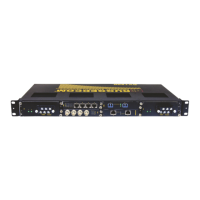
Do you have a question about the RuggedCom RuggedBackbone RX1500 and is the answer not in the manual?
| Power Supply | Dual redundant, hot-swappable power supplies |
|---|---|
| Switching Capacity | Up to 128 Gbps |
| Operating Temperature Range | -40°C to +85°C |
| Mounting | DIN rail or panel mount |
| Certifications | IEEE 1613, IEC 61850-3, EN 50155, EN 50121-4 |
| Power Input | 24/48VDC or 110/220 VAC |
| Enclosure | Rugged metal |
| Type | Modular Layer 3 switch |
Covers initial access, structure, and configuration changes for the ROX™ web interface.
Details administration menu, system commands, access control, user accounts, and software upgrades.
Explains NTP fundamentals and guides on configuring system time, timezone, and NTP servers.
Covers IP interfaces, configuring IPv4/IPv6 addresses, and simple network setups.
Introduces IPv6 fundamentals, neighbor discovery, VLAN interfaces, and non-switched interface menus.
Describes alarm system, subsystems, behavior, clearing, acknowledging, and configuration.
Explains the DNS menu and the procedure for performing domain name lookups.
Details configuring local and remote syslog connections and deleting log files.
Covers SNMP traps, access configuration, discovery, users, security, and access control.
Describes RADIUS server configuration and PPP/CHAP authentication with Windows IAS.
Details NETCONF sessions, state, and statistics for network configuration.
Covers chassis status, power controller, slot hardware, CPU, sensors, and module configuration.
Guides on PPP configuration for users, including dial-in, dial-out, and link failover.
Explains the DHCP Relay Agent menu and form for forwarding DHCP/BOOTP requests.
Details DHCP fundamentals, network organizations, and server configuration for interfaces, subnets, and options.
Covers Ethernet port features, controller protection, parameters, rate limiting, and diagnostics.
Provides features for gathering and reporting Ethernet statistics, including basic, port, and non-switched statistics.
Shows status of configured interfaces, IP addresses, and routable interface statistics.
Introduces virtual switches for Layer 2 bridging and discusses configuration and sample use cases.
Explains Link Aggregation for bundling Ethernet ports for higher bandwidth and reliability.
Details PPP and cellular modem fundamentals, HSPA, Edge, CDMA configuration, and account activation.
Covers serial protocols applications, concepts, TCP Modbus, DNP, and serial port configuration.
Details T1/E1 fundamentals, Frame Relay, WAN configuration, and protocols like PPP, MLPPP, HDLC-ETH, DDS.
Provides features for authorizing network access using Static MAC or IEEE 802.1X authentication.
Details features for supporting multicast groups, IGMP snooping, GMRP, and troubleshooting.
Explains CoS operation, inspection, forwarding phases, configuration, and mapping.
Covers MAC address table management, viewing, configuring learning options, static MACs, and purging.
Explains RSTP and MSTP operation, states, roles, parameters, statistics, and troubleshooting.
Details VLAN features, operation, types, configuration, and troubleshooting.
Supports LLDP for automated network discovery, covering operation, parameters, and neighbor information.
Provides an overview of IP routing, Ethernet ports, and how ROX™ switches and routes IP packets.
Covers Layer 3 switching fundamentals, rules, ARP table, multicast switching, and firewall interaction.
Details IPsec VPNs, Layer 2 Tunnelling (GOOSE, Generic), and GRE tunnels.
Explains RIP, OSPF, and BGP fundamentals, configuration, parameters, and example networks.
Covers static routing configuration, including route types, gateway, blackhole, and interface options.
Details viewing IPv4/IPv6 routing tables, memory statistics, and protocol status (RIP, OSPF, BGP).
Explains enabling dynamic or static multicast routing and configuring multicast groups.
Covers firewall fundamentals, NAT, zones, policies, rules, and VPN configuration.
Details Traffic Control modes (basic/advanced), configuration, interfaces, priorities, and rules for traffic shaping.
Explains VRRP fundamentals, solution, terminology, configuration, and status monitoring.
Covers configuring link failover settings, backup interfaces, ping targets, and testing.
Provides detailed steps for preparing, launching, and monitoring software upgrades.
Describes configuration procedures for FreeRADIUS and Microsoft IAS for RuggedBackbone™ access.
Details requirements and setup for a repository server for software upgrades.
Provides procedures for shutting down the unit, adding modules, and swapping modules.
Presents the terms and conditions of the GNU General Public License.